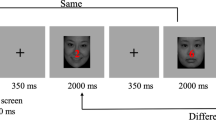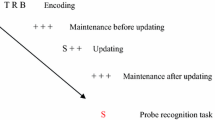Abstract
Background
Updating is a crucial function responsible of working memory integrity, allowing relevant information to be active and inhibiting irrelevant one; updating has been studied mainly with verbal stimuli, less with faces, stimuli with high adaptive value and social meaning.
Aim
Our aim was to test age-related differences in updating for different stimuli in three different age groups: young adults (range 20–30 years), young-old (range 60–75 years) and older-old participants (range 77–87 years).
Methods
To this end, we administered control measures (i.e., vocabulary and visuospatial tasks), span tasks (forward, backward) and two updating tasks: one with no socially relevant material (i.e., letters) and another one with socially relevant material (i.e., human faces, where, in particular, the combination between facial expression and gaze direction was manipulated). In both tasks we collected response times (RTs) at different steps of an updating task (i.e., encoding, maintaining, and updating goal-relevant information).
Results and discussion
We found that age linearly produces an increase in processing speed regardless the stimulus considered, either letter or human face. However, with face stimuli, the magnitude of the difference is greater for the letter updating task, than for the face updating task. In turn, the results claim for a stimulus-specific updating process as the age-related decline is less pronounced when socially meaningful stimuli are involved than when no socially meaningful ones are.




Similar content being viewed by others
References
Babcock RL, Salthouse TA (1990) Effects of increased processing demands on age differences in working memory. Psychol Aging 5:421–428. https://doi.org/10.1037//0882-7974.5.3.421
Mikels JA, Larkin GR, Reuter-Lorenz PA et al (2005) Divergent trajectories in the aging mind: changes in working memory for affective versus visual informatin with age. Psychol Aging 14:117–121. https://doi.org/10.1037/0882-7974.20.4.542
Morris RG, Gick ML, Craik FIM (1988) Processing resources and age differences in working memory. Mem Cogn 16:362–366. https://doi.org/10.3758/BF03197047
Morris M, Jones DM (1990) Memory updating in working memory: the role of central executive. Br J Psychol 81:111–121. https://doi.org/10.1111/j.2044-8295.1990.tb02349.x
Palladino P, Cornoldi C, De Beni R et al (2001) Working memory and updating process in reading comprehension. Mem Cogn 29:344–354. https://doi.org/10.3758/BF03194929
Artuso C, Cavallini E, Bottiroli S et al (2017) Updating working memory: memory load matters with aging. Aging Clin Exp Res 29:371–377. https://doi.org/10.1007/s40520-016-0581-y
Hartman M, Dumas J, Nielsen C (2001) Age differences in updating working memory: evidence from the delayed-matching-to-sample test. Aging Neuropsychol Cogn 8:14–35. https://doi.org/10.1076/anec.8.1.14.847
Van der Linden M, Bredart S, Beerten A (1994) Age-related differences in updating working memory. Br J Psychol 8:145–152. https://doi.org/10.1111/j.2044-8295.1994.tb02514.x
Ebner NC, Fischer H (2014) Emotion and aging: evidence from brain and behavior. Front Psychol 5:996. https://doi.org/10.3389/fpsyg.2014.00996
Ebner NC, Johnson MK (2009) Young and older emotional faces: are there age group differences in expression identification and memory? Emotion 9:329–339. https://doi.org/10.1037/a0015179
McDowell CL, Harrison DW, Demaree HA (1994) Is right hemisphere decline in the perception of emotion a function of aging? Int J Neurosci 79:1–11. https://doi.org/10.3109/00207459408986063
Suzuki A, Akiyama H (2013) Cognitive aging explains age-related differences in face-based recognition of basic emotions except for anger and disgust. Aging Neuropsychol Cogn 20:253–270. https://doi.org/10.1080/13825585.2012.692761
Truong L, Yang L (2014) Friend or foe? Decoding the facilitative and disruptive effects of emotion on working memory in younger and older adults. Front Psychol 5:94. https://doi.org/10.3389/fpsyg.2014.00094
Carstensen LL, Isaacowitz DM, Charles ST (1999) Taking time seriously A theory of socioemotional selectivity. Am Psychol 54:165–181. https://doi.org/10.1037//0003-066x.54.3.165
Mather M, Carstensen LL (2005) Aging and motivated cognition: the positivity effect in attention and memory. Trends Cogn Sci 9:496–502. https://doi.org/10.1016/j.tics.2005.08.005
Wong J, Peterson M, Thompson J (2008) Object similarity in visual working memory: a face-specific memory effect. J Vis 8:1174–1174. https://doi.org/10.1167/8.6.1174
Haxby JV, Hoffman EA, Gobbini MI (2000) The distributed human neural system for face perception. Trend Cogn Sci 4:223–233. https://doi.org/10.1016/S1364-6613(00)01482-0
Adams RB, Kleck RE (2005) Effects of direct and averted gaze on the perception of facially communicated emotion. Emotion 5:3–11. https://doi.org/10.1037/1528-3542.5.1.3
Artuso C, Palladino P, Ricciardelli P (2012) How do we update faces? Effects of gaze direction and facial expressions on working memory updating. Front Psychol 3:362. https://doi.org/10.3389/fpsyg.2012.00362
Artuso C, Palladino P, Ricciardelli P (2015) Social updating: the role of gaze direction in updating and memorizing emotional faces. Social Cogn 33:543–561. https://doi.org/10.1521/soco.2015.33.6.543
De Beni R, Palladino P (2004) Decline in working memory updating through ageing: intrusion error analyses. Memory 12:75–89. https://doi.org/10.1080/09658210244000568
Berger N, Richards A, Davelaar EJ (2018) Differential effects of angry faces on working memory updating in younger and older adults. Psychol Aging 33:667–673. https://doi.org/10.1037/pag000026
Berger N, Richards A, Davelaar EJ (2017) When emotions matter: Focusing on emotion improves working memory updating in older adults. Front Psychol 8:1565. https://doi.org/10.3389/fpsyg.2017.01565
Salthouse TA (1990) Working memory as a processing in cognitive aging. Dev Rev 10:101–124. https://doi.org/10.1016/0273-2297(90)90006-P
Salthouse TA (1991) Theoretical perspectives on cognitive aging. Psychology Press, London
Faul F, Erdfelder E, Lang A et al (2007) G*Power 3: a flexible statistical power analysis program for the social, behavioral, and biomedical sciences. Behav Res Methods 39:175–191. https://doi.org/10.3758/BF03193146
Folstein MF, Folstein SE, McHugh PR (1975) Mini-mental state. A practical method for grading the cognitive state of patients for the clinician. J Psychiatr Res 12:189–198. https://doi.org/10.1016/0022-3956(75)90026-6
United Nations (2015) World Population Ageing 2015. (New York, NY, US: Department of Economic and Social Affairs, Population Division), ST/ESA/SER.A/390. https://www.un.org/en/development/desa/population/publications/pdf/ageing/WPA2015_Report.pdf
Belacchi C, Artuso C (2018) How taxonomic and thematic associations in semantic memory modulate recall in young through old-old adults. Psychol Aging 33:1060–1069. https://doi.org/10.1037/pag0000297
Thurstone LL, Thurstone TG (1963) Italian edition 1981. PMA: Batteria delle attitudini mentali primarie, 7–11 anni [PMA: Primary mental abilities, 7–11 years]. Edizioni Giunti OS: Firenze
Soresi S (2016) Psicologia delle disabilità e dell'inclusione. [Psychology of disabilities] Il mulino, Bologna
Artuso C, Palladino P (2011) Content-context binding in verbal working memory updating: on-line and off-line effects. Acta Psychol 136:363–369. https://doi.org/10.1016/j.actpsy.2011.01.001
Artuso C, Palladino P (2014) Binding and content updating in working memory tasks. Br J Psychol 105:226–242. https://doi.org/10.1111/bjop.12024
Artuso C, Palladino P (2018) How sub-lexical association strength modulates updating: cognitive and strategic effects. Mem Cogn 46:285–297. https://doi.org/10.3758/s13421-017-0764-6
Langner O, Dotsch R, Bijlstra G et al (2010) Presentation and validation of the Radboud Faces Databases. Cogn Emot 24:1377–1388. https://doi.org/10.1080/02699930903485076
Baltes PB (1987) Theoretical propositions of life-span developmental psychology: On the dynamics between growth and decline. Dev psychol 23:611–626. https://doi.org/10.1037/0012-1649.23.5.611
Baltes PB, Baltes MM (1990) Successful aging: prospective from the behavioural sciences. Cambridge University Press, Cambridge
Cohen J (1988) Statistical power analysis for the behavioral sciences. Lawrence Earlbaum Associates, Hillsdale
Todorov A, Said CP, Engell AD et al (2008) Understanding evaluation of faces on social dimension. Trends Cogn Sci 12:455–460. https://doi.org/10.1016/j.tics.2008.10.001
Bindemann M, Burton AM, Langton SR (2008) How do eye gaze and facial expression interact? Vis Cogn 16:708–733. https://doi.org/10.1080/13506280701269318
Vuilleumier P, George N, Lister V et al (2005) Effects of perceived mutual gaze and gender on face processing and recognition memory. Vis Cogn 12:85–101. https://doi.org/10.1080/13506280444000120
Acknowledgements
We wish to thank Monica Zenucchi for her help with participants recruiting and data collection and Tim Vaughan for revising the English.
Funding
CA and PP were supported by a grant Blue Sky Research (BRS) 2017 Established Investigator awarded to PP. PR was supported by a grant 2016-ATE-0346-Fondo di Ateneo University of Milano-Bicocca.
Author information
Authors and Affiliations
Corresponding author
Ethics declarations
Conflict of interest
The authors have declared that no conflict of interest exists.
Ethical approval
The ethical committee of the Department Psychology of the University of Milano-Bicocca approved this study.
Informed consent
Written informed consent was given by all participants prior to participation.
Additional information
Publisher's Note
Springer Nature remains neutral with regard to jurisdictional claims in published maps and institutional affiliations.
Rights and permissions
About this article
Cite this article
Artuso, C., Palladino, P. & Ricciardelli, P. Memory updating through aging: different patterns for socially meaningful (and not) stimuli. Aging Clin Exp Res 33, 1005–1013 (2021). https://doi.org/10.1007/s40520-020-01604-1
Received:
Accepted:
Published:
Issue Date:
DOI: https://doi.org/10.1007/s40520-020-01604-1





